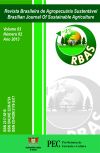EFFECT OF SILICON, NITROGEN AND POTASSIUM ON INDUSTRIAL TOMATO PRODUCTION
DOI:
https://doi.org/10.21206/rbas.v3i2.223Abstract
Tomato production is at second place among vegetable crops in Brazil in economical relevance. The aim of this research was to evaluate silicon, nitrogen and potassium effect on yield. The experiment was carried out at FAL-UnB in a completely randomized design, with 14 forms of fertilization (control - no fertilization; 2, 4, 6 and 8 kg ha-1 of SiO2; 60, 120, 180 e 240 kg ha-1 of nitrogen; 100, 200, 300 e 400 kg ha-1 of K2O; NPK according to soil analyses), three genotypes (Viradoro, Tospodoro and HEI 035) in two periods of evaluation/ harvest, totalizing 84 treatments, in four replicates, in a total of 336 experimental parcels. A MAPA norm was used to evaluate yield and classify fruits. The lowest fertilizers doses in each nutrient resulted in the highest yield of adequate tomato fruits for processing. HEI 035 showed the lowest discolored and insect damaged fruits, statistically different from those observed on the other genotypes. Nevertheless, HEI 035 showed the highest fruit number with black heart disorder, statistically different from Tospodoro´s result, which was the lowest. The highest number of cracked fruits in each nutrient dose was observed at the lowest dose, and did not differ statistically from control, but differed from NPK that showed the lowest result. HEI 035 showed the highest number of blossom-end rot fruits. It can be concluded that the lowest fertilizer doses in each fertilizer (silicon, nitrogen and potassium) result in the highest yield of adequate tomato fruits for processing.Downloads
Download data is not yet available.
Downloads
Published
2013-12-30
How to Cite
Ana Lúcia Hanisch2, José Alfredo da Fonseca2, Alvadi Antonio Balbinot Junior3, & Evandro Spagnollo4. (2013). EFFECT OF SILICON, NITROGEN AND POTASSIUM ON INDUSTRIAL TOMATO PRODUCTION. Brazilian Journal of Sustainable Agriculture, 3(2). https://doi.org/10.21206/rbas.v3i2.223
Issue
Section
Artigos
License
1. Proposta de Política para Periódicos de Acesso Livre
Autores que publicam nesta revista concordam com os seguintes termos:
Autores mantém os direitos autorais e concedem à revista o direito de primeira publicação, com o trabalho simultaneamente licenciado sob a Licença Creative Commons Attribution que permite o compartilhamento do trabalho com reconhecimento da autoria e publicação inicial nesta revista.











